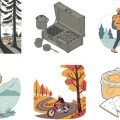Understanding Nutrition Needs for Hikers
When planning meals for family or group day hikes, it’s essential to understand the unique nutrition needs of both adults and children. Hiking, even at a leisurely pace, requires more energy than everyday activities, so your body needs the right balance of nutrients to stay fueled and feel great on the trail. Carbohydrates are your primary source of quick energy—think whole grain breads, fruits, and trail mix. Proteins help support muscle repair and keep you feeling satisfied, so pack foods like lean meats, cheese sticks, hard-boiled eggs, or plant-based protein bars. Healthy fats from nuts, seeds, and avocados provide long-lasting energy and help absorb key vitamins. For children, it’s important to offer smaller, frequent snacks that are easy to eat and digest. Hydration is also crucial; water should be prioritized over sugary drinks to prevent dehydration. Remember that everyone’s needs can vary depending on age, activity level, and personal health conditions. Planning ahead with balanced meals ensures every hiker stays energized, happy, and healthy throughout your outdoor adventure.
Planning Balanced Hiking Meals
Creating a well-balanced meal plan for family and group day hikes is key to keeping everyone energized, happy, and healthy on the trail. Start by considering your group’s size, ages, activity level, and any specific dietary needs. Whether you’re hiking with young children, teens, or adults, tailoring your food choices ensures every hiker gets the nutrition they need while enjoying delicious meals together.
Understanding Portion Sizes
Portion sizes can vary depending on age and energy expenditure. Children typically require less food than adults, but active kids may need more than you expect. Here’s a simple guideline to help you portion meals:
| Age Group | Main Meal (per meal) | Snacks (per snack time) |
|---|---|---|
| Children (4-8 yrs) | 1 cup grains + 2 oz protein + 1/2 cup veggies/fruit | Small fruit, 1 granola bar |
| Tweens/Teens (9-16 yrs) | 1.5 cups grains + 3 oz protein + 1 cup veggies/fruit | Fruit + trail mix or energy bar |
| Adults | 2 cups grains + 4 oz protein + 1-1.5 cups veggies/fruit | Fruit + nuts or jerky |
Catering to Dietary Restrictions
In the U.S., it’s common for hikers to have allergies or follow special diets such as vegetarian, gluten-free, or dairy-free. Before your hike, check in with your group about any restrictions or preferences. For inclusive planning:
- Nuts & Allergies: Choose seed-based snacks or sunbutter sandwiches instead of peanut butter.
- Vegetarian/Vegan: Pack plant-based proteins like hummus wraps, lentil salads, and roasted chickpeas.
- Gluten-Free: Use corn tortillas, rice cakes, or gluten-free bread for sandwiches.
- Dairy-Free: Opt for nut milks or vegan cheese alternatives in recipes.
Selecting Age-Appropriate Foods
Younger children may prefer familiar foods that are easy to eat and not too messy—think string cheese, bite-sized fruit, and mini sandwiches. Teens might appreciate heartier options like burritos or pasta salads that satisfy growing appetites. Adults often enjoy a variety of flavors and textures; consider including international-inspired wraps or quinoa bowls to keep things interesting.
Sample Day Hike Menu by Age Group
| Breakfast | Lunch | Snack Options | |
|---|---|---|---|
| Kiddos | Oatmeal cups + banana slices | Tortilla roll-ups with turkey & cheese | Sliced apples, pretzels, yogurt tubes |
| Tweens/Teens | Bagel with cream cheese & fruit cup | Pasta salad with veggies & chicken strips | Trail mix, granola bars, orange wedges |
| Adults | Muesli with dried fruit & nuts + coffee thermos | Quinoa salad with beans & roasted veggies in pita bread | Nuts/seeds mix, jerky, dark chocolate squares |
A Final Tip: Keep It Simple and Fun!
The best hiking meals are those that pack easily, taste great cold or at room temperature, and suit everyone’s dietary needs. Involve your family or group in choosing and prepping food to make mealtime a highlight of your outdoor adventure!

3. Smart Packing and Food Safety
Packing food for a family or group day hike isn’t just about what you bring—it’s also about how you pack and keep it safe to eat. When hiking with kids or friends, smart packing can make your mealtime easier, safer, and more enjoyable for everyone.
Choose Lightweight and Portable Options
Opt for foods that are easy to carry and won’t weigh down your backpack. Think granola bars, trail mix, dried fruit, nut butter packets, cheese sticks, tortillas, and jerky. For lunch, wraps are less likely to get squished than sandwiches. Single-serving items or foods that don’t require refrigeration are perfect for the trail.
No-Spill Solutions for Hassle-Free Eating
Leak-proof containers are a must when hiking with groups or children. Invest in reusable silicone bags, sturdy bento boxes, or small screw-top jars to keep snacks fresh and mess-free. Avoid glass containers to reduce weight and the risk of breakage. Pre-portion snacks at home so everyone can grab their own bag—this helps avoid spills and keeps things organized.
Food Safety Tips on the Trail
Keeping food safe is essential for a fun and healthy hike. Always wash hands or use hand sanitizer before eating. If you’re packing perishable foods like hard-boiled eggs or yogurt tubes, use ice packs in an insulated lunch bag and eat those items first. Never leave food in direct sun for long periods, and pack out all trash to protect wildlife and the environment.
By planning ahead with lightweight, no-spill containers and focusing on food safety, you’ll ensure that every family or group hike is fueled by delicious—and safe—meals everyone can enjoy together.
4. Creative Snack and Meal Ideas
When it comes to family or group day hikes, keeping everyone energized and satisfied is all about planning fun, tasty, and nutritious snacks and meals. Here are some creative ideas that both kids and adults will love—and that are easy to pack and eat on the trail.
Kid-Friendly Snacks
| Snack | Why It’s Great | How to Pack |
|---|---|---|
| Trail Mix with a Twist (nuts, seeds, dried fruit, mini pretzels, chocolate chips) | Customizable, sweet & salty, energy-boosting | Individual zip-top bags or reusable containers |
| Sliced Apples with Nut Butter Packets | Filling fiber + protein combo | Pre-sliced apples in baggies; single-serve nut butter packs |
| Crispy Roasted Chickpeas | Crunched-up protein and fiber; allergy-friendly | Small resealable containers or snack bags |
| Granola Bars (homemade or store-bought) | No mess, quick energy boost, kid-approved flavors | Keep in original wrappers for convenience |
| Bite-sized Cheese Cubes & Whole Grain Crackers | Calcium and grains for sustained energy | Airtight containers to keep cheese cool and crackers crisp |
Simple Hiking Lunches Everyone Will Love
| Meal Idea | Nutritional Benefits | Packing Tips |
|---|---|---|
| Tortilla Roll-Ups (turkey/cheese/veggies or hummus/spinach/avocado) | Balanced proteins, carbs & veggies; easy to customize for picky eaters or dietary needs | Wrap tightly in foil or beeswax wraps for easy eating on-the-go |
| Pita Pockets Stuffed with Chicken Salad or Bean Spread & Veggies | Protein-rich; sneaks in extra veggies; hearty and satisfying | Pack pitas separately from fillings to avoid sogginess, assemble when ready to eat |
| Pasta Salad with Cherry Tomatoes, Mozzarella Balls & Olive Oil Dressing (or plant-based alternatives) | Crowd-pleaser; includes healthy fats, protein & fiber; can be served cold or at room temperature | Store in leak-proof containers; include forks/spoons for serving on the trail |
Treats That Travel Well
If you’d like to surprise your group with something special, try homemade oatmeal cookies with dried fruit, dark chocolate-dipped strawberries packed in a chilled container, or no-bake energy bites made from oats, honey, and peanut butter. These treats are just as delightful at a scenic overlook as they are around your kitchen table.
Tips for Making It Fun and Inclusive:
- Let kids help assemble their own snacks before the hike—this gets them excited to eat what they’ve helped make.
- Create a “snack box” with a mix of options so everyone can pick their favorites during rest breaks.
- Be mindful of allergies by labeling snacks clearly if you’re hiking with multiple families.
Nourishment Can Be Exciting!
The key to memorable hiking meals is variety: mix colors, textures, and flavors so every break feels like a picnic adventure. With these ideas in your backpack, everyone—from toddlers to teens to grown-ups—will stay happy, healthy, and fueled for the day’s explorations.
5. Staying Hydrated on the Trail
Proper hydration is just as important as packing nutritious meals when planning a successful family or group day hike. Dehydration can sneak up quickly, especially when you’re busy exploring, so understanding the essentials of hydration is key for everyone’s well-being and enjoyment.
How Much Water Should You Bring?
A general rule of thumb for day hikes is to bring at least half a liter (about 17 ounces) of water per person per hour of moderate activity. If it’s hot, sunny, or you’re hiking more strenuously, aim for closer to one liter (about 34 ounces) per hour. For families with young children or older adults, consider bringing extra water just in case. It’s always better to have too much than not enough.
Tips for Keeping Everyone Hydrated
- Use Refillable Bottles or Hydration Packs: Encourage each family member to carry their own reusable bottle or hydration pack so they can sip regularly rather than waiting until they feel thirsty.
- Set “Water Break” Reminders: Make hydration fun by scheduling mini “water cheers” every 30-45 minutes, especially if your group includes kids who may forget to drink while they play and explore.
- Add Some Flavor: If plain water gets boring, add natural flavors like lemon slices, berries, or mint leaves. Electrolyte tablets or powder packets are also handy for longer hikes and can make drinking water more appealing.
Encouraging Kids to Drink Enough
Kids can be distracted by all the excitement on the trail and may not recognize thirst cues. Give them colorful bottles or let them decorate their own before the trip. Turn sipping into a game—see who can take the most “sips” at each water stop! Praise and gentle reminders go a long way in keeping little ones hydrated and happy throughout your adventure.
Staying hydrated isn’t just about comfort; it helps prevent fatigue, headaches, and overheating so your hiking crew can stay energized and safe. By making hydration part of your meal planning routine, you’ll set everyone up for a great day outdoors!
6. Allergy-Friendly and Special Diet Tips
Planning meals for family or group day hikes can get tricky when you need to accommodate food allergies or special diets. But with a little preparation, you can keep everyone safe, happy, and well-nourished—without extra stress. Here are some practical tips to help you navigate allergy-friendly and special dietary needs on your next hike.
Start with Clear Communication
Before the hike, check in with all group members about any food allergies, intolerances, or dietary restrictions such as gluten-free, dairy-free, vegetarian, or vegan. Encourage open communication and make sure everyone feels comfortable sharing their needs. It’s helpful to create a shared list so nothing gets overlooked.
Choose Simple, Whole-Food Snacks
Whole foods like fresh fruit, cut veggies, hard-boiled eggs, and unsalted nuts (if nut allergies aren’t an issue) are naturally free from many common allergens and don’t require complicated prep. For those with specific allergies, consider allergen-free granola bars or seed-based snacks instead of traditional trail mixes.
Label Everything Clearly
If you’re prepping food for a group, label all containers with ingredients and potential allergens. This makes it easy for everyone to identify safe options and avoid cross-contact. Using color-coded containers or stickers is a simple way to add an extra layer of safety.
Keep Food Separate
Pack allergy-friendly foods in separate containers and use different utensils for preparing and serving these items. If possible, designate one cooler or section of your backpack just for allergy-safe foods. Remind kids and adults not to share food unless they’re sure it’s safe.
Have Backup Options
Always bring a few backup snacks that meet the strictest dietary needs in your group. Individually wrapped allergy-friendly snack bars or shelf-stable meal packs can be a lifesaver if plans change or someone’s food accidentally gets contaminated.
Be Prepared for Emergencies
If anyone in your group has severe allergies, make sure at least two people know how to use an epinephrine auto-injector and where it’s kept. Carry a basic first aid kit and know the fastest route back to your car or help if needed.
With thoughtful planning and clear communication, accommodating allergies and special diets doesn’t have to add stress to your hiking adventure. Focus on simple ingredients, organization, and safety so everyone can enjoy the great outdoors together!


